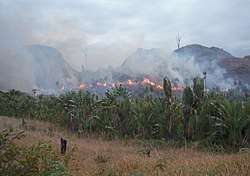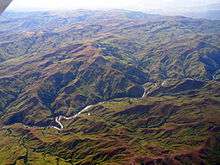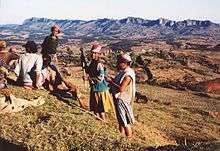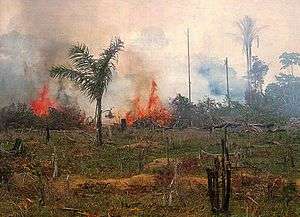Deforestation in Madagascar
Deforestation in Madagascar is an ongoing environmental issue. Deforestation [1] creates agricultural or pastoral land but can also result in desertification, water resource degradation, biodiversity erosion and habitat loss, and soil loss.

It has been noticed that Madagascar has lost 80 or 90% of its 'original' or 'pre-human' forest cover, but this claim is difficult to prove and is not supported by evidence.[2][3] What is certain is that the arrival of humans on Madagascar some 2000+ years ago began a process of fire, cultivation, logging and grazing that has reduced forest cover. Industrial forest exploitation during the Merina monarchy[4] and French colonialism[5] contributed to forest loss. Evidence from air photography and remote sensing suggest that by c. 2000, around 40% to 50% of the forest cover present in 1950 was lost.[3][6][7] Current hotspots for deforestation include dry forests in the southwest being converted for maize cultivation and rain forests in the northeast exploited for tropical hardwoods.[8]
Primary causes of forest loss include slash-and-burn for agricultural land (a practice known locally as tavy) and for pasture, selective logging for precious woods or construction material, the collection of fuel wood (including charcoal production) and, in certain sites, forest clearing for mining.[9][10]
History of deforestation in Madagascar
Early history
Deforestation by life in Madagascar by human intervention first made an impact on its highland forests as early as AD 600 in the establishment of swidden fields by Indonesian settlers.[11] The creation of swidden fields is a subsistence method of agriculture that has been practised by humans across the globe for over 12000 years by means of a slash and burn technique that clears an area in preparation for crop growth.[12] An increase in the rate of forest removal was seen around AD 1000 with the introduction of cattle from Africa, compelling Malagasy islanders to expand their grassland grazing areas. Historical records point to the importance that this impact has caused with the disappearance of most of Madagascar’s highland forest by 1600 AD.[13] Attempts to conserve Madagascar’s forests were introduced by French rulers in the establishment of environmental regulations, the earliest being seen in 1881 when Queen Ranavalona II placed a ban on using slash and burn techniques in agriculture.[14] These efforts aimed to protect the future of the countries rainforests, however, it has been estimated that over 80 percent of Madagascar’s original forests are gone with half of this loss occurring since the late 1950s.[14]
Recent history
Early estimates of deforestation in Madagascar were unreliable until using data taken over a 35-year period from a combination of aerial photography, taken in 1950, and more recently data from satellite imagery available since 1972 were used to clearly see the extent of rainforest cleared in the eastern areas of Madagascar.[15] By 1985, only 50 percent of the 7.6 million hectares that existed in 1950 remained equating to an average deforestation rate of over 111,000 hectares per year[15] and by 2005 the country had seen a total of 854,000 hectares of forest lost since 1990.[14] Since the first evidence of human occupation less than 2000 years ago the island of Madagascar’s population in 2002 had grown to about 12 million people (McConnell, 2002). Agricultural fires, erosion and soil degradation continue to contribute to the degradation of the countries ecological stability impeding forest regrowth[13] and according to recent data taken over the 2001 – 2012 period the rate of forest loss in Madagascar’s has continued to increase.[14]
Causes
Agriculture
The primary cause for deforestation in Madagascar is the slash and burn practice. Historically and culturally known as “Tavy,” the process involves setting vegetation alight after being cut down, creating potential land for rice cultivations.[16] Coupled with the establishment of rural communities who undertake farming,[17] hectares of forest are lost to agriculture.
Population increase
Since the 1940s, the population in Madagascar has rapidly increased, putting pressure on the land available for housing and farming. Thousands of hectares of rainforest have been cut down in order to provide for the increased population.
Fuelwood
As 40% of Madagascar’s rural population lives in poverty and has little to no access to electricity, they have to resort to using fuelwood for completing daily tasks. Consuming approximately 100 kg of fuelwood monthly, Madagascan households use this energy for cooking, home heating and lighting[18]
Timber

The Masoala Peninsula, in Madagascar’s east, consists of valuable hardwood timber. Mostly ebony and rosewood, rainforests are degraded in order to satisfy a high demand within the international market.[14][19]
Illegal logging
Illegal logging in Madagascar has been a problem for decades and is perpetuated by extreme poverty and government corruption. Often taking the form of selective logging, the trade has been driven by high international demand for expensive, fine-grained lumber such as rosewood and ebony.[20] Historically, logging and exporting in Madagascar have been regulated by the Malagasy government, although the logging of rare hardwoods was explicitly banned from protected areas in 2000. Since then, government orders and memos have intermittently alternated between permitting and banning exports of precious woods. The most commonly cited reason for permitting exports is to salvage valuable wood from cyclone damage, although this reasoning has come under heavy scrutiny. This oscillating availability of Malagasy rosewood and other precious woods has created a market of rising and falling prices, allowing traders or "timber barons" to stockpile illegally sourced logs during periodic bans and then flood the market when the trade windows open and prices are high.[21]
Environmental Impacts
Biodiversity
Since its divergence from Africa over 88 million years ago, Madagascar has evolved into an incredibly biodiverse island.[22] Including more than 13000 plants and 700 vertebrates,[22] close to 90% of Madagascar’s species are endemic and are found nowhere else in the world.[23] However, with deforestation depleting key habitats and food resources, over 8000 species are either classified as vulnerable or endangered and some, including 15 species of lemur, have actually gone extinct.[24] Coupled with its geographic isolation thus increasing vulnerability to destruction,[23] deforestation will continue to impact Madagascar’s flora and fauna, increasing rates of extinction.
Soil & Water

Like many habitats that undergo deforestation, Madagascar experiences soil erosion, of which can adversely affect river systems and lakes. In the case of Lake Alaotra in Ambatondrazaka area, in the country’s east, deforestation in the hills above has caused heavy erosion, leading to increased sedimentation in the lake. As result, Lake Alaotra has actually decreased in size by approximately 30% in last 40 years. Moreover, the water quality of the lake has suffered, thus reducing the productivity of neighbouring rice cultivations.[25] Soil can also become infertile after vegetation clearing. When plants die or shed their leaves, micro-organisms in soil decompose the leaf litter as they consume it, breaking it down to key nutrients valuable to future plant growth. Should this biomass be removed, there will be no nutrient recycling, reducing soil fertility and reducing plant growth.[23]
Atmosphere and Climate
Deforestation in Madagascar, as well as other parts of the world, can have an influence on climate. When the forest is cleared, the understorey is left exposed to the sun to a greater extent than before. This increased sunlight reduces soil moisture and increases rates of evapotranspiration in plants, ultimately dehydrating them and stunting growth.[26] At a global level, deforestation is also known to have an effect on carbon dioxide levels in the atmosphere through;
- Slash and Burn Practices: Used primarily to create agricultural land, it involves the logging of forests and burning debris afterwards.[26]
- Disruption of Photosynthesis: Plants absorb atmospheric carbon dioxide, as well water, in order to form their biomass and oxygen.[27] Without plants, carbon dioxide is not absorbed.
It is with the loss of crucial carbon sinks and continuation of slash and burns deforestation that carbon dioxide levels will continue to increase in the atmosphere, ultimately contributing to global warming.[26]
Economic Impacts
Economic impacts of deforestation in Madagascar closely align with the degradation of its natural environment and resources. Examples exist within;
Agriculture

While a key cause of deforestation,[16] agriculture can also be one of its victims. Without vegetation to anchor soil, the chance of erosion increases, sending close to 400 tonnes/ha of sediment into waterways annually.[16] As a result, water quality decreases and coupled with a lack of nutrient cycling due to little biomass, plant productivity is reduced, including valuable rice crops;.[28][29]
Medicine
As a product of its biodiversity, Madagascar has a vast array of plant species, with 2,300 having medicinal properties that treat many illness, from common ailments to cancers.[30] Should deforestation continue, the pharmaceutical industry will lose a key resource, eventually suffering decreases in profit.[31]
Ecotourism
Madagascar possesses a vast array of species, 90% of which are only unique to the island.[29] With deforestation destroying habitats and causing increased extinctions, Madagascar will potentially lose a great tourism asset, eliminating incentive to invest in ectourism operations (such as resorts, recreational facilities, and national parks), thus decreasing long-lasting employment opportunities for local communities.[30]
Reforestation efforts
Despite the deforestation trend, tree cover is increasing in some parts of the country, though largely of introduced (non-native) species such as Eucalyptus (various species), pine (Pinus kesiya, Pinus patula,) silver wattle (Acacia dealbata), silky oak (Grevillea banksii), and paperbark/niaouli ("Melaleuca quinquenervia"). Some of these trees are planted by foresters and farmers; others have become invasive of their own accord.[32][33][34] Reforestation by eucalypts, pines, and wattles has been demonstrated, for instance, in the central highlands.[35]
Reforestation efforts with native species, particularly in rainforest corridors, have had mixed success. Some reforestation efforts have been conducted by Rio Tinto, a mining organization. This effort includes the set-up of 2 tree nurseries near Fort Dauphin. The nurseries are called the Rio Tinto QMM's nurseries. The nurseries plant some 600 tree species native to Madagascar.[36][37] However, in 2003, Rio Tinto also announced plans to mine ilmenite (used to make toothpaste and paint) in southern Madagascar. These plans included the creation of a new port, roads, and other facilities. Mostly migrant workers would be employed, despite high levels of unemployment in the region. This unemployment and poverty drives charcoal production, which is a major factor in deforestation in that region.[38]
See also
| Wikimedia Commons has media related to Deforestation in Madagascar. |
- Environment of Madagascar
- Wildlife of Madagascar
- Deforestation by region
References
- Saving the Wildlife of Madagascar, TIME, September 25, 2008
- McConnell, William; Kull, Christian (2014). "Protecting lemurs: Madagascar's forests". Science. 344 (6182): 358. Bibcode:2014Sci...344..358M. doi:10.1126/science.344.6182.358-a. PMID 24763569.
- McConnell, William; Kull, Christian (2014). "Deforestation in Madagascar: debates over the island's forest cover and challenges of measuring forest change" (PDF). Conservation and Environmental Management in Madagascar, Ed. Ivan R. Scales (London, Routledge-Earthscan): 67–104.
- Campbell, Gwyn (2013). "Forest Depletion in Imperial Madagascar, c.1790–1861". Contest for Land in Madagascar: Environment, Ancestors and Development, Edited by S. Evers, G. Campbell & M. Lambek (Leiden: Brill).: 63–96.
- Jarosz, Lucy (1993). "Defining and explaining tropical deforestation: shifting cultivation and population growth in colonial Madagascar (1896-1940)". Economic Geography. 69 (4): 366–379. doi:10.2307/143595. JSTOR 143595. PMID 12318844.
- Allnutt, Thomas; et al. (2008). "A method for quantifying biodiversity loss and its application to a 50-year record of deforestation across Madagascar". Conservation Letters. 1 (4): 173–181. doi:10.1111/j.1755-263X.2008.00027.x.
- Deforestation causes species extinction in Madagascar
- Harper, Grady; Steininger, Marc; Tucker, Compton; Juhn, Daniel; Hawkins, Frank (2007). "Fifty years of deforestation and forest fragmentation in Madagascar". Environmental Conservation. 34 (4): 325–333. doi:10.1017/s0376892907004262.
- Mittermeier, R.A.; Konstant, W.R.; Hawkins, F.; Louis, E.E.; Langrand, O.; Ratsimbazafy, J.; Rasoloarison, R.; Ganzhorn, J.U.; Rajaobelina, S.; Tattersall, I.; Meyers, D.M. (2006). "Chapter 4: Conservation of Lemurs". Lemurs of Madagascar. Illustrated by S.D. Nash (2nd ed.). Conservation International. pp. 52–84. ISBN 1-881173-88-7.
- Zhu, Annah. 2017. "Rosewood Occidentalism and Orientalism in Madagascar." Geoforum Available at: https://doi.org/10.1016/j.geoforum.2017.08.010
- Gade, D; Sussman, R (1996). "Mountain Research and Development". Mountain Research and Development. International Mountain Society. 16 (2): 101–116. doi:10.2307/3674005. JSTOR 3674005.
- Stief, C (2017). "Slash and Burn Agriculture- An Overview of Slash and Burn". Geography.about.com.
- Gade, D (1996). "Mountain Research and Development". Mountain Research and Development. International Mountain Society. 16 (2): 101–116. doi:10.2307/3674005. JSTOR 3674005.
- Butler, R (2014). "Madagascar".
- Green, M; Sussman, R (1990). "). Deforestation History of the Eastern Rain Forests of Madagascar from Satellite Images". Science. New Series. 248 (4952): 212–215. Bibcode:1990Sci...248..212G. doi:10.1126/science.248.4952.212. PMID 17740137.
- Jorgen, K (2002). "Deforestation in the Madagascar Highlands". GeoJournal. 56 (3): 191–199. doi:10.1023/A:1025187422687. ProQuest 223672089.
- Brooks, C.P.; Holmes, C; Kramer, K; Barnett, B; Keitt, T.H. (2009). "The Role of Demography and Markets in Determining Deforestation Rates Near Ranomafana National Park, Madagascar". PLOS ONE. 4 (6): e5783. Bibcode:2009PLoSO...4.5783B. doi:10.1371/journal.pone.0005783. PMC 2691994. PMID 19536282.
- NASA. "Deforestation in Madagascar". Lcluc.umd.edu.
- Zhu, Annah. 2017. "Rosewood Occidentalism and Orientalism in Madagascar." Geoforum Available at: https://doi.org/10.1016/j.geoforum.2017.08.010
- Zhu, Annah. 2020. "China’s Rosewood Boom: A Cultural Fix to Capital Overaccumulation." Annals of the American Association of Geographers. Available at: https://doi.org/10.1080/24694452.2019.1613955
- Anonymous. 2018. "Rosewood democracy in the political forests of Madagascar." Political Geography. Available at: https://doi.org/10.1016/j.polgeo.2017.06.014
- Scales, Ivan R. (2014). Conservation and Environmental Management in Madagascar (1st ed.). Hoboken: Taylor and Francis.
- Smith, Thomas M.; Smith, Robert Leo (2015). Elements of Ecology (9h ed.). Harlow, England: Pearson. ISBN 9781292077406.
- Clark, Megan (2015). "Deforestation in Madagascar: Consequences of Population Growth and Unsustainable Agricultural Processes" (PDF). Global Majority e-Journal. 3 (1): 61–71.
- Bakoariniaina, Lao Nathalie; Kusky, Timothy; Raharimahefa, Tsilavo (2006). "Disappearing Lake Alaotra: Monitoring catastrophic erosion, waterway silting, and land degradation hazards in Madagascar using Landsat imagery". Journal of African Earth Sciences. 44 (2): 241–252. Bibcode:2006JAfES..44..241B. doi:10.1016/j.jafrearsci.2005.10.013.
- "Soil Erosion and Degradation". World Wildlife Foundation. World Wildlife Foundation. Retrieved 2017. Check date values in:
|accessdate=(help) - Reece, Jane B.; Taylor, Martha R.; Simon, Eric J.; Dickey, Jean L. (2015). Campbell Biology Concepts & Connections (8th ed.). England: Pearson Education Limited.
- Bakoariniaina, L; Kusky, T; Raharimahefa, T (2006). "Monitoring catastrophic erosion, waterway silting, and land degradation hazards in Madagascar using Lansat imagery". Journal of African Earth Sciences. 44: 241–252. Bibcode:2006JAfES..44..241B. doi:10.1016/j.jafrearsci.2005.10.013.
- Smith, T.M.; Smith, R.L (2015). Elements of Ecology (9 ed.). Harlow, Essex: Pearson.
- "Making conservation work in Madagascar". Wildmadagascar.org. 2017.
- "ecoDestinations-Madagascar". ecotourism.org. The International Ecotourism Society.
- Carriere, Stephanie; Randriambanona. "Biodiversité introduite et autochtone: antagonisme ou complémentarité? Le cas de l'eucalyptus à Madagascar" (PDF). Bois et Forêts des Tropiques. 292 (2): 5–21. Archived from the original (PDF) on 2015-10-24.
- Kull, Christian; Tassin, Jacques; Rangan, Haripriya (2007). "Multifunctional, scrubby, and invasive forests? Wattles in the highlands of Madagascar". Mountain Research and Development. 27 (3): 224–231. doi:10.1659/mrd.0864.
- Tassin, Jacques (2009). "Evaluation préliminaire des risques d'invasion par les essences forestières à Madagascar" (PDF). Bois et Forêts des Tropiques. 299 (1): 27–36. doi:10.19182/bft2009.299.a20420. Archived from the original (PDF) on 2015-10-24.
- Kull, Christian (2012). "Air photo evidence of historical land cover change in the highlands: wetlands and grasslands give way to crops and woodlots". Madagascar Conservation and Development. 7 (3): 144–152. doi:10.4314/mcd.v7i3.7.
- IUCN report on Rio Tinto mines in Madagascar
- Indian Ocean With Simon Reeve documentary
- "Deforestation of Tropical Rainforests - A Case Study of Madagascar" (PDF). Geocases. 2005. Archived from the original (PDF) on 30 October 2013. Retrieved 30 October 2013.
